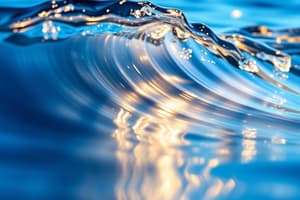Podcast
Questions and Answers
What is the definition of a transverse wave?
What is the definition of a transverse wave?
- Particles move perpendicular to the wave motion. (correct)
- Particles move parallel to the wave motion.
- Particles move in a circular path.
- Particles do not move.
What happens when light passes from a denser medium to a less dense medium?
What happens when light passes from a denser medium to a less dense medium?
- It speeds up and bends towards the normal.
- It reflects off the boundary.
- It slows down and bends away from the normal.
- It speeds up and bends away from the normal. (correct)
What does Snell's Law describe?
What does Snell's Law describe?
- The relationship between angles of incidence and refraction. (correct)
- The reflection of waves in a uniform medium.
- The destructive interference of waves.
- The speed of sound in different mediums.
In constructive interference, the waves combine to produce:
In constructive interference, the waves combine to produce:
What is the critical angle in terms of light refraction?
What is the critical angle in terms of light refraction?
What is a node in a standing wave pattern?
What is a node in a standing wave pattern?
When sound waves travel through different mediums, how does temperature affect their speed?
When sound waves travel through different mediums, how does temperature affect their speed?
What characterizes a longitudinal wave?
What characterizes a longitudinal wave?
What occurs when a wave strikes a fixed boundary?
What occurs when a wave strikes a fixed boundary?
What is required to create a standing wave?
What is required to create a standing wave?
How does the size of an aperture affect diffraction?
How does the size of an aperture affect diffraction?
What relationship exists between amplitude and loudness?
What relationship exists between amplitude and loudness?
What happens to the pitch of a sound when the source moves toward an observer?
What happens to the pitch of a sound when the source moves toward an observer?
What is the formula for the frequency of standing waves in pipes with one end open and one end closed?
What is the formula for the frequency of standing waves in pipes with one end open and one end closed?
What defines the beat frequency between two waves?
What defines the beat frequency between two waves?
What is true about the speed of sound in different media?
What is true about the speed of sound in different media?
Flashcards
Wave
Wave
A disturbance that transmits energy but not matter.
Transverse Wave
Transverse Wave
Particles move perpendicular to the wave's direction.
Longitudinal Wave
Longitudinal Wave
Particles move parallel to the wave's direction.
Refraction
Refraction
Signup and view all the flashcards
Optical Density
Optical Density
Signup and view all the flashcards
Superposition Principle
Superposition Principle
Signup and view all the flashcards
Constructive Interference
Constructive Interference
Signup and view all the flashcards
Destructive Interference
Destructive Interference
Signup and view all the flashcards
Reflected Wave
Reflected Wave
Signup and view all the flashcards
Standing Wave
Standing Wave
Signup and view all the flashcards
Diffraction
Diffraction
Signup and view all the flashcards
Standing Wave Formula (string)
Standing Wave Formula (string)
Signup and view all the flashcards
Standing Wave Formula (pipe)
Standing Wave Formula (pipe)
Signup and view all the flashcards
Beats
Beats
Signup and view all the flashcards
Beat Frequency
Beat Frequency
Signup and view all the flashcards
Doppler Effect
Doppler Effect
Signup and view all the flashcards
Study Notes
Physics Waves
- A wave is a disturbance or vibration that transmits energy, not matter.
- Transverse wave: Particles move perpendicular to the wave motion.
- Longitudinal wave: Particles move parallel to the wave motion.
- Surface wave: Combination of transverse and longitudinal waves.
- Amplitude: Maximum displacement from crest to trough.
Refraction
- Refraction: Bending of light as it changes medium.
- Optical density: Measure of how difficult it is for light to travel in a substance.
- Angle of incidence: Angle between incident ray and normal.
- Angle of refraction: Angle between refracted ray and normal.
- Light refracts away from the normal when passing from a denser to less dense medium.
- Light slows down and bends towards the normal when passing from a less dense to a denser medium.
- Critical angle: Angle of incidence that results in an angle of refraction of 90 degrees. This results in total internal reflection.
Reflection and Transmission
- If the medium remains constant, waves travel at a uniform speed.
- Sound waves travel faster in solids as particles are closer together.
- Waves act differently when passing through different mediums and temperatures.
- Reflected pulses from fixed ends invert.
- Reflected pulses from free ends do not invert.
Interference
- Superposition principle: Sum of amplitudes of individual waves.
- Constructive interference: Waves with the same frequency and phase combine, increasing amplitude.
- Destructive interference: Waves with the same frequency but opposite phases combine, cancelling out or reducing amplitude.
- Standing waves are formed by constructive and destructive interference of waves traveling in opposite directions.
- Nodes are areas of complete destructive interference with zero amplitude.
- Antinodes are areas of complete constructive interference with maximum amplitude.
- Waves reflecting from fixed boundaries invert.
Diffraction
- Diffraction occurs when the wavelength of a wave is comparable to the size of an obstacle or aperture.
- Diffraction causes bending of waves around obstacles.
- Smaller apertures lead to more pronounced diffraction effects.
Standing Waves
- Standing waves form when two waves of equal amplitude, frequency, and wavelength travel in opposite directions.
- Standing waves on strings with two fixed ends have frequencies f = nv/2L.
- Standing waves in pipes with one fixed and one open end have frequencies f = nv/4L.
Sound Waves
- Sound waves are longitudinal waves of pressure, stimulating ear drums.
- Sound speed depends on the medium's density: denser medium = faster sound.
- Frequency determines pitch, and amplitude determines volume.
- Beats are periodic fluctuations of sound intensity when waves with similar frequencies interfere; beat frequency is |f2 – f1|.
Doppler Effect
- Doppler effect: Apparent change in frequency of a wave when the source or observer is moving relative to the medium.
- Moving source toward an observer increases the apparent frequency.
- Moving source away from an observer decreases the apparent frequency.
Studying That Suits You
Use AI to generate personalized quizzes and flashcards to suit your learning preferences.





